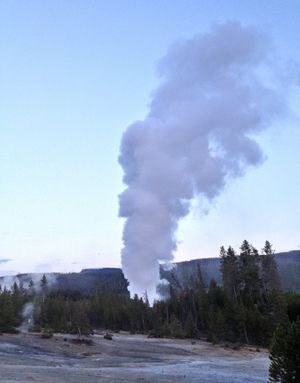Yellowstone’s tallest geyser blows for first time in 8 years
PARKS -- It's not the most faithful geyser in Yellowstone National Park, but on the rare occasion that it blows, it's the world's tallest.
Steamboat Geyser erupted on Wednesday for the first time in more than eight years.
The nine-minute blast sent steaming hot water an estimated 200 to 300 feet in the air, park geologist Hank Heasler said.
Unlike the park’s popular and famous Old Faithful geyser, which spews water like clockwork every hour-and-a-half, no one knows when Steamboat will erupt next.
In the past, it’s gone as long as 50 years without a major event. In 1964, it erupted a record 29 times. The last blast came in 2005.
Steamboat is one of more than 500 geysers at Yellowstone, which boasts the largest collection of hydrothermal features in the world.
The geyser is in a popular viewing area known as the Norris Geyser Basin. According to the Associated Press, its eruption at about 7:30 p.m. Wednesday drew dozens of excited onlookers who were at the right place at the right time, said Robb Long, a freelance photographer from Sioux Falls, S.D., who was visiting the park with his fiance and her family.
“It was an amazing experience. This thing sounded like a locomotive,” Long told AP. “Everybody was frantic, taking pictures. People were running down there trying to get to it before it went away, and park rangers were running around trying to gather up people so they didn’t get too close.”
Yellowstone’s geysers are fueled by cold water that feeds into a natural underground plumbing network, where heat from the park’s volcano forces chemical-laden water to the surface and causes the periodic eruptions, Heasler said.
Early accounts of Steamboats eruptions came from first-hand observations, with the first recorded in 1878.

